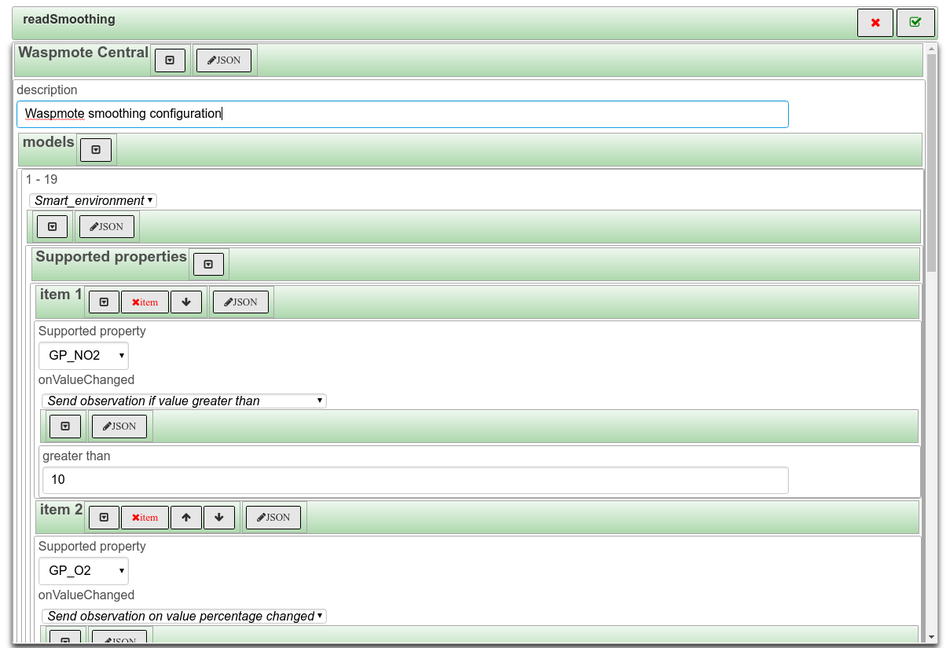WaspmoteBLECentral
From AMTech WikiDocs
WaspmoteBLECentral is a thing type that implements a BLE Central to communicate with Libelium waspmote model using the BLE protocol /amtech/linkeddata/types/composite/entity/waspmoteBLECentral. The Arduino sketch running on the Libelium waspmote model should construct the BLE advertisement package following the next guideline:
- Write the local attribute containing the device name value "WBLE" BLE.writeLocalAttribute(3, deviceName);
- Build a custom BLE advertisement packet
- First byte package size
- Second byte MANUFACTURER_SPECIFIC_DATA Identifier 0xff
- Third byte Libelium BLE waspmote identifier LIBELIUM_BLEID
- Fort byte waspmote model identifier example GAS_PRO = 19 (see waspmote model documentation)
- Fifth byte first 4 bits total number of sensors that will be sent in all advertisement packets last 4 bits the amount of sensors values send in current packet
- Sixth a message number that should increment with a advertisement packet sent
- Next bytes must be set with read sensor value a byte with the id of the sensor from Libelium WaspFrame.h and the value(s) read b the sensor
- WaspmoteBLECentral logic uses sensor values type and size from Libelium document data_frame_guide.pdf Sensor ID Table page 13
- The following c function generates a custom BLE advertisement packet for a Gases_PRO waspmote model sending read from 5 sensors SENSOR_ACC, SENSOR_BAT, SENSOR_IN_TEMP, SENSOR_GP_TC and SENSOR_GP_HUM.
#define MSGADDITIONAL_SIZE 29;
int buildAdditionalSensors()
{
int ms = 0; ;
memset(advData, 0x00, sizeof(advData));
advData[ms++]= MSGADDITIONAL_SIZE;
advData[ms++]= AD_TYPE_MANUFACTURER_SPECIFIC_DATA;
advData[ms++] = LIBELIUM_BLEID;
advData[ms++] = Gases_PRO;
advData[ms++] = (uint8_t)(10 | (5 <<4));
advData[ms++] = msgNumber++;
showValue(msgNumber, "msgNumber", ms);
//1 SENSOR_ACC
advData[ms++] = SENSOR_ACC;
int x = ACC.getX();
int y = ACC.getY();
int z = ACC.getZ();
memcpy( &advData[ms], &x, sizeof(int) );
ms += sizeof(int);
memcpy( &advData[ms], &y, sizeof(int) );
ms += sizeof(int);
memcpy( &advData[ms], &z, sizeof(int) );
ms += sizeof(int);
showACCValues(x,y,z, ms);
//2S ENSOR_BAT
advData[ms++] = SENSOR_BAT;
uint8_t vuint = PWR.getBatteryLevel();
memcpy( &advData[ms], &vuint, sizeof(uint8_t) );
ms += sizeof(uint8_t);
showValue(vuint, "SENSOR_BAT", ms);
//3 SENSOR_IN_TEMP
advData[ms++] = SENSOR_IN_TEMP;
float vfloat = RTC.getTemperature();
memcpy( &advData[ms], &vfloat, sizeof(float) );
ms += sizeof(float);
showValue(vfloat, "SENSOR_IN_TEMP", ms);
//4 SENSOR_GP_TC
advData[ms++] = SENSOR_GP_TC;
memcpy( &advData[ms], &temperature, sizeof(float) );
ms += sizeof(float);
showValue(temperature, "SENSOR_GP_TC", ms);
//5 SENSOR_GP_HUM
advData[ms++] = SENSOR_GP_HUM;
memcpy( &advData[ms], &humidity, sizeof(float) );
ms += sizeof(float);
showValue(humidity, "SENSOR_GP_HUM", ms);
return ms;
}
- Smoothing configuration can be set by Waspmote model and sensors id leveraging property readSmoothing
